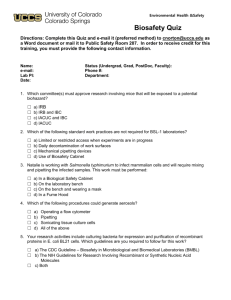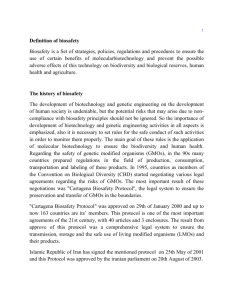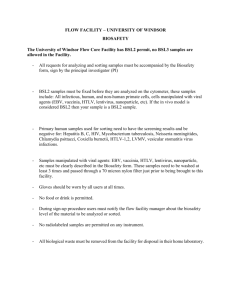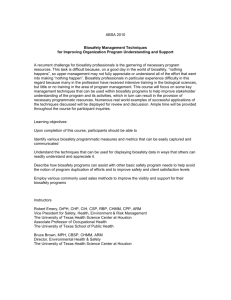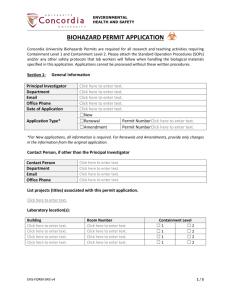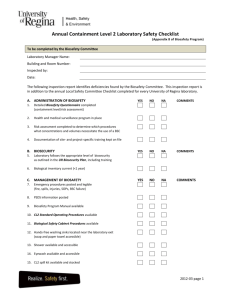Biosafety Program - Fort Lewis College
advertisement
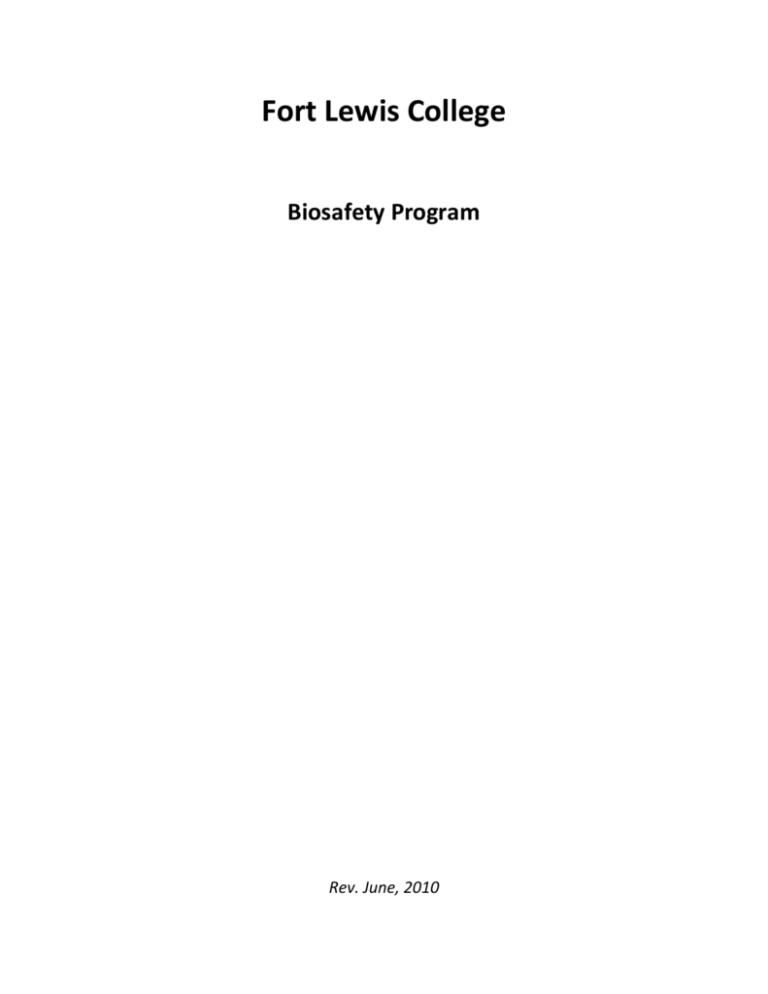
Fort Lewis College Biosafety Program Rev. June, 2010 Table of Contents Section Page 1.0 Introduction 1 2.0 Definition of Biohazard Agents 1 3.0 Physical Containment 1 4.0 Prohibited Research Activities 2 5.0 Biosafety Committee (BC) 2 6.0 Biological Safety Officer 3 7.0 Responsibilities of Investigators 4 8.0 Responsibilities of Department Chairperson 5 9.0 Consideration of the Liability Aspects of Working with Biohazard Agents 5 10.0 General Laboratory Rules for the Use of Biohazardous Material 5 11.0 Labeling of Facilities or Work Areas Used for Biohazardous Materials and Laboratory Signage 6 12.0 Efficiency of Fume Hoods and Certification of Biological Safety Cabinets 7 13.0 Shipment of Biohazard Materials to or from Fort Lewis College 7 14.0 Regulatory Compliance 8 15.0 Training and Information 8 16.0 Current Members of the BioSafety Committee 9 17.0 List of Standard Operating Procedures 10 18.0 Appendices 10 Fort Lewis College – Biosafety Program The Biosafety Program at Fort Lewis College (FLC) was established to ensure safe handling of biological agents, safe disposal of infectious laboratory wastes, safe research behavior and compliance with college policies, state law and national regulatory standards. Fort Lewis College expanded its research activities in 2010 in to include research with Hanta virus within the new building addition to Berndt Hall, which houses a level two biosafety laboratory (BSL 2). In conjunction with this expansion the College established its first Biosafety Committee. The Fort Lewis College Biosafety Committee (IBC) has the responsibility to review all research projects involving etiologic agents before research is started. The committee has the responsibility to protect faculty, staff, students, visitors and the local community and environment in regards to all research activities. The committee will be comprised of the Dean of Natural and Behavioral Sciences, the Department Chair of the Biology Department, one faculty researcher, the Director of Environmental Health & Safety (EH&S) and one member from the public sector. The EH&S representative will serve as coordinator for the committee to ensure all precautionary measures are being followed, as well as to schedule the annual calibration check and any servicing of the biosafety cabinet. Secondary duties will include training, inspections and/or audits of the biosafety lab and work practices, regulatory compliance review and other tasks agreed upon during committee meetings. 1.0 INTRODUCTION The purpose of this manual is to describe the operation of the biosafety program, to provide guidelines for the safe operation of the biosafety laboratory and safe performance of experiments involving potentially hazardous biological agents. Additional requirements not currently listed in this document may be added in the future as deemed necessary as promulgated by the Colorado Department of Public Health and Environment (CDPH&E) or federal agencies passing new laws or updates in regards to existing rules and regulations. Faculty, staff, students and visiting researchers are urged to carefully review this document which focuses on college requirements, researcher responsibilities and liabilities. This document may be found on the Biological Sciences and the EH&S websites. 2.0 DEFINITION OF BIOHAZARDOUS AGENTS A biohazardous agent is defined as one that is capable or potentially capable of producing an undesirable effect upon humans or the environment. The agent may be a biological or their metabolic product. Recommended safety guidelines for handling and use of these agents are described in this document. Additional information may be found in the Biology Department’s Chemical Hygiene Program. Currently the only agents defined as biohazards are the Hanta virus, including Sin nombre. 3.0 PHYSICAL CONTAINMENT Experiments with infectious agents and other potentially hazardous substances are expected to be performed under containment conditions which minimize the possibility of dissemination both within and outside the laboratory area. In regards to Hantavirus the containment level is identified by the Centers of Disease Control and Prevention (CDC) as Biosafety Level 2 (BL2), a level that has the potential of serious human disease, up to and including death. A description of physical conditions and recommended safe lab work practices required in a BL2 is given in the reference manual "Biosafety in Microbiological and Biomedical Laboratories" by the Center of Disease Control and Prevention/National Institute of Health (CDC/NIH). 4.0 PROHIBITED RESEARCH ACTIVITIES The following types of studies are prohibited at Fort Lewis College: Experiments with etiologic agents requiring BL3 or BL4 levels of containment Experiments with animal pathogens (Class V) that are forbidden from entry into the United States Experiments with plant pathogens or vectors for which the U.S. Department of Agriculture may refuse to issue a permit for importation or interstate movement. Formation of recombinant DNA's derived from pathogenic organisms or from cells known to be infected with such agents, regardless of the host-vector system used. Large scale propagation (more than 10 liters of culture) of recombinant DNA containing organisms that require BL3 or higher containment conditions and practices. Creation by the use of recombinant DNA of a plant pathogen with increased virulence and host range beyond that which occurs by natural genetic exchange. Deliberate release into the environment of any organism containing recombinant DNA, unless specifically approved in writing by the National Institute of Health (NIH) or the Environmental Protection Agency (EPA). Transfer of a drug-resistant trait to microorganisms that are not known to acquire it naturally, if such acquisition could compromise the use of a drug to control disease agents in human or veterinary medicine or agriculture. Agents or toxins listed in the Department of Health and Human Services “Possession, Use and Transfer of Select Agents and Toxins” rule. 5.0 BIOSAFETY COMMITTEE (BC) The Dean of Physical Sciences and Natural Resources will appoint members to the Biosafety Committee (BC). In order to provide the quality of input needed for consideration of research activities presenting real or potential hazards, the membership shall include persons knowledgeable in microbiology, infectious disease, medicine, chemistry, toxicology, occupational health and safety, animal experimentation, public health, applicable law, biological safety and policies of Fort Lewis College. Currently, the BC has five (5) members, of which four (4) are FLC faculty and staff and one (1) community member. Chair and other officers are elected annually at the fall semester meeting. The Biosafety Committee has the responsibility of assessing dangers and potential environmental impacts associated with investigations involving biological agents and making recommendations for safe conduct of such studies. It also functions on behalf of Fort Lewis College to ensure that the experimental work is performed in compliance with current laws, policies and guidelines. All requests for action by the BC should be put in writing and submitted to the Biosafety Officer. It will be the responsibility of the Biosafety Officer (1) to determine when and how often the BC is to meet, (2) to officially inform appropriate person(s) of the actions taken by the BC, and (3) to see that a complete file is kept of minutes of meetings and of all documents and reports received by the. The Biosafety Officer will coordinate the activities of the BC with the chairperson and maintain a complete set of records. It is important for faculty and staff members to understand that certain information in BC files may be subjected to public scrutiny under a disclosure provision of current NIH guidelines and public record laws. This disclosure provision requires Fort Lewis College, upon request, to make available to the public all minutes of Biosafety Committee meetings and any documents or reports submitted or received from federal funding agencies which the latter are required to make public (e.g., Memoranda of Understanding and Agreement, reports of guidelines, violations and significant research related incidents, facilities inspection reports, and agency directives to modify projects). In addition, FLC is required to forward to NIH any comments by members of the public concerning actions taken by the BC together with the response of the committee to these comments. Review and Approval of Biohazardous Studies The BC cannot be expected to effectively carry out its designated functions unless it has adequate knowledge beforehand of the biohazardous work to be undertaken on campus. Therefore, all research projects involving etiologic agents or other potentially infectious material must be reviewed and approved in writing by the BC. It is the concern of this committee to know whether or not the safety precautions proposed for the experimental work appear to be adequate for protection of personnel and the environment. In general, the review process will focus on: (1) Qualifications of the investigator (2) Agents to be employed (3) Risks presented by experimental procedures (4) Adequacy of containment equipment and facilities (5) Training level of persons directly associated with the work (6) Need for health surveillance of laboratory personnel (7) Regulatory compliance, and (8) Other factors relevant to safe conduct of the study and compliance with regulations and appropriate guidelines. The Principal Investigator (PI) and the BC must concur on all matters relating to containment requirements, safe practices, and handling procedures for biohazardous agents. In event of nonconcurrence, the recommendations of the Committee shall prevail until such time as they are modified or rescinded by appellate decision of appropriate college officials, starting with the Dean of Natural and Behavioral Sciences. 6.0 BIOLOGICAL SAFETY OFFICER The Biological Safety Officer (BSO) represents the Environmental Health and Safety office and is primarily responsible for continuity and compliance of the biosafety program at Fort Lewis College. Major responsibilities are as follows: Assist in the preparation and periodic updating of a biosafety manual which is in accordance with FLC policy, consistent with government regulatory guidelines, and best professional practices. Provide consultation to investigators on matters relating to laboratory safety, appropriate handling and containment of biohazardous agents, decontamination, and disposal of infectious wastes. Aid investigators in the development of appropriate emergency measures for dealing with accidental spills and personnel contamination. Surveillance of laboratories in which biohazardous agents are employed to ensure compliance with prescribed safety guidelines and prompt correction of any noted deficiencies. Investigate incidents involving biohazardous agents to determine causes and necessary corrections. Upon completing the investigation, the Biosafety Officer will prepare a written report of findings for review and action, if any, by the BC. Review plans for new facilities and modifications of existing structures. Develop, arrange, or conduct training programs for laboratory personnel using biohazardous agents in cooperation with the appropriate department. Serve as liaison between Fort Lewis College and regulatory agencies concerned with the use of biohazardous agents. The Biological Safety Officer, upon concurrence by the Dean of Natural & Behavioral Sciences or the chairperson of the BC (or in his/her absence, by at least two (2) other technically qualified members of the Committee), may temporarily stop any work with etiologic agents or other regulated materials that creates a recognized hazard to personnel, the public or environment, or involves experiments prohibited by the institution. The entire BC then will review the problem and forward written recommendation(s) to the Dean of Natural & Behavioral Sciences for final action. 7.0 RESPONSIBILITIES OF INVESTIGATORS The investigator is expected to be familiar with relevant safety guidelines described in this document, contained in the Standard Operating Procedures (SOPs) and according to national best practices. The investigator shall personally monitor and be responsible for the day-to-day operation of the laboratory, and to take all necessary steps for protection of staff, students, and the general public against undesirable consequences of experimental work conducted at Fort Lewis College and/or during field studies. The investigator is also expected to be familiar with other regulations appropriate to their laboratory work, such as Occupational Safety and Health Administration (OSHA), Colorado Department of Public Health and Environment (CDPH&E), Centers for Disease Control and Prevention (CDC) and the National Institute for Health (NIH). Additional duties of the investigator are as follows: Thoroughly inform all persons directly involved in hazardous experiments, e.g., infectious agents and harmful chemicals, of the potential health risk presented and the safety procedures necessary to minimize exposure. Failure to do so may be considered negligent on the part of the investigator. Establish emergency procedures to be followed in the event of an overt spill or contamination with potentially hazardous biological material. These procedures should be posted in a prominent place in the laboratory. Moreover, it is recommended that a responsible member of the laboratory staff be designated to handle emergency situations whenever the principal investigator is absent from the premises. Immediately report any unusual incident, such as spill, break in containment, or overt contamination, to the Biosafety Officer and to the Department Chairperson. In case of injury or suspected injury, an Incident Report Form is available from the Human Resource office. The Incident report forms must be completed immediately and the principal investigator must conduct an investigation and return the form to the Human Resources Office immediately afterwards. If a needle stick or sharps injury is involved, a sharps injury form must be filled out and attached to the Incident Report form. Post access doors and interior of the laboratory with biohazard warning signs. Arrange for health surveillance of laboratory personnel if deemed appropriate for the research project. Cooperate with Biosafety Officer or regulatory personnel during inspection visits and other projects. Implement and keep appropriate records for all biosafety activities and required OSHA programs related to labs, such as Chemical Hygiene, Bloodborne Pathogens, Personal Protective Equipment, Ventilation and Training documentation. Monitor the use and maintenance of all safety equipment and devices. 8.0 RESPONSIBILITIES OF DEPARTMENT CHAIRPERSON The Department Chair is responsible for the general safety of faculty, staff, and students working with biohazardous agents in his/her department. It should be emphasized that this responsibility is in no way altered by the duties of the Biosafety Committee and/or Biosafety Officer. The Department Chair shall: Ensure that each principal investigator in his/her area of jurisdiction is provided with a copy of this document and should stress the importance of compliance with the guidelines therein. Communicate with the principal investigator and to the Biosafety Committee of work involving biohazardous agents and reporting incidents involving such agents to the Biosafety Officer. Ensure, along with faculty members supervising teaching laboratories, that students receive proper instructions relative to the precautions needed when working with pathogenic microorganisms. 9.0 CONSIDERATION OF THE LIABILITY ASPECTS OF WORKING WITH BIOHAZARDOUS AGENTS All faculty members and investigators should be aware of their exposure to personal liability in performance of research and teaching involving biohazardous agents. This applies whether a faculty member is working with a biohazardous agent or pursuing other routine duties of teaching, research, and administration. The increased potential for personal injury in a laboratory where persons are working with biohazardous agents is presumed to be known or should have been known. As injuries are most likely to involve employees and students, the most important responsibilities of a principal investigator are adequate instruction to other personnel handling a biohazardous agent about how it should be handled and adequate supervision of such persons. The actual degree of instruction and supervision necessary in each case will depend upon the project and the degree of education and sophistication of the persons involved. 10.0 GENERAL LABORATORY RULES FOR THE USE OF BIOHAZARDOUS MATERIAL All laboratory personnel are expected to be familiar with the following rules and to conduct their work in accordance with them: Storage of food in refrigerators or freezers used for infectious materials, or chemical carcinogens is not permitted. In addition, there should be no eating, drinking, smoking, chewing of tobacco, application of cosmetics, shaving, brushing of teeth, or storage of food in areas where these biohazardous materials are stored or used. Outer street clothing (coats, hats, etc.) should not be kept in an area where accidental contamination with infectious or other hazardous materials can occur. Contaminated lab coats cannot be taken home or laundered at home. Mechanical pipetting aids should be used when pipetting any biohazardous material. Mouth pipetting is never permitted. Hands should be washed immediately after completion of any procedure in which biohazardous material is used. Persons working with infectious material should be especially careful not to inadvertently touch theie face or eyes with unwashed hands. Rubber or plastic gloves should be worn when working with an etiologic agent as they may cause infection by entry through skin abrasions. Gloves must be worn when one anticipates hand contact with blood, potentially infectious materials, mucous membranes, or non-intact skin. Vinyl and latex single-use, disposable gloves should be replaced as soon as possible if contaminated, torn, punctured or damaged in any way. Never wash these gloves or decontaminate them for reuse. Be aware of the possibility that employees and students may have allergies to latex which can be life-threatening to some individuals. When chemical hazards are also present more extensive consideration of the many available types of glove material is necessary. Long hair, beards, and loose-fitting clothing are potentially dangerous when working near an open flame, biohazard materials that could be inadvertently spilled, or moving laboratory equipment. Tying back hair or employment of hairnets should be encouraged in all laboratories. Keep jewelry to a minimum and do not wear dangling jewelry in the lab. Protection of the eyes is a matter which should be given high priority in every laboratory. Signs indicating the appropriate type(s) of eye protection required must be prominently displayed in all areas where a hazardous exposure may exist. Contact lenses provide little or no practical protection to the eyes. In fact, foreign material present on the surface of the eye often becomes trapped beneath the contact lens, and similarly entrapped caustic chemicals, irritating vapors, and infectious agents cannot be readily washed from the eye without removal of the lenses. Supervisors and/or instructors are responsible for the enforcement of all regulations regarding the wearing of safety glasses, splash goggles, use of contact lenses, and the use of additional eye protection. Consideration should be given to whether a person should be permitted to work alone on a biohazardous laboratory operation. Emergency situations often necessitate actions by others if someone is contaminated in the incident, such as a spill, in order to prevent injury and avoid additional contamination away from the spill site. The PI shall evaluate and set lab policy in this regard. Procedures or activities likely to produce aerosols of infectious material must be conducted in an approved biological safety cabinet. Centrifuges, sonicators, blenders, and shaking equipment require special attention because they can disperse aerosols easily if not operated with proper precaution. The researcher must insure proper experimental set-up in the biosafety cabinet and proper use of the cabinet by all personnel. All biohazardous materials must be placed in rigid, leak proof containers labeled with a biohazard symbol for intra-campus transport between buildings or from one laboratory to another located in the same building. 11.0 LABELING OF FACILITIES OR WORK AREAS USED FOR BIOHAZARDOUS MATERIALS AND LABORATORY SIGNAGE The entrance to work areas containing Class 2 etiologic agents, all biological safety cabinets, incubators, refrigerators, and freezers used for infectious materials shall be posted with "BIOHAZARD" signs. This is the minimum signage requirement. Where regulations require higher levels of warning signage, this shall be done. The equipment must be kept locked at all times when located in an area accessible to persons other than laboratory personnel. A sign or label giving the name(s) and telephone number(s) of responsible person(s) who may be contacted in case an emergency occurs when the laboratory is not in operation, should be affixed to BIOHAZARD signs posted at the entrance to work areas and on biohazard storage facilities located in unrestricted corridors and rooms. It is recommended that the name of the infectious agent be on the sign so that emergency personnel can assess the scene without entering the laboratory in an emergency. Due consideration should be given to lab security as well. 12.0 EFFICIENCY OF FUMEHOODS AND CERTIFICATION OF BIOLOGICAL SAFETY CABINETS Experience has shown that there is considerable variation in the operational efficiency of fume hoods installed in laboratories at FLC, and some may not always provide the recommended average inward air velocity of at least 100 feet per minute. In view of this circumstance, magnahelic pressure gauges or flow gauges have been installed on all campus fume hoods so that researchers can monitor proper operation on a continuing basis. Contact EHS if you need assistance or training in fume hood use. An outside testing company will be contracted every year to test fume hoods for proper operation. Maintenance is done by FLC Physical Plant Services Department. Any time that improper operation or problems are suspected you should immediately contact the Physical Plant at 247-7000. Researchers are responsible for the daily inspection of the hood to insure the magnahelic gauges are operating and that the hood is used in a proper manner. The capability of a biological safety cabinet to protect laboratory personnel and the environment from exposure to potentially hazardous aerosols is primarily dependent on proper functioning of the cabinet. No biological safety cabinet should be used to contain hazardous materials unless it has been demonstrated by appropriate test procedures to meet minimum safety specifications. A certification company label indicating the date of service and other pertinent information will be affixed to each safety cabinet that conforms to minimum performance standards. If a cabinet fails to meet performance standards, person(s) using the cabinet will be promptly informed as to the nature of the problem and how it can be corrected. Please notify the EHS officer as well. The cabinet must not be used until repaired. 13.0 SHIPMENT OF BIOHAZARDOUS MATERIALS TO OR FROM FORT LEWIS COLLEGE The transport of any biohazardous material from FLC or from other facilities owned or leased by FLC shall be in accordance with current federal and state regulations governing the packaging, labeling, and shipment of such materials. Included are animal pathogens or their harmful products and specimens reasonably believed to contain viable infectious agents. The transfer of some highly infectious agents and deadly toxins is regulated by the Possession, Use, and Transfer of Select Agents and Toxins Rule (“Select Agents Rule”). Fort Lewis College is not currently licensed or authorized to receive these agents. References for packaging and shipping requirements can be found on the Department of Transportation (DOT) website in Appendix I under Federal Agencies and Regulations. Airline requirements can be found on the International Air Transport Association (IATA) website in Appendix I under Standards and Organizations. The U.S. Postal Service also has regulations for shipment of hazardous materials. In addition, most airlines have their own requirements. 14.0 REGULATORY COMPLIANCE Fort Lewis College strives to be in compliance will all federal, state, and local regulations, as well as applicable agency guidelines. This is possible to the extent that adequate staff and resources are provided to EHS and other departments on campus and cooperation is received from researchers and their departments. Fort Lewis College is regulated in whole or in part by numerous regulations and guidelines. It is the primary investigator and departments’ direct responsibility to comply with and find all regulatory requirements required for their research initiatives. No experimental program shall be initiated until adequate, safe, and compliant facilities, equipment, and training are completed and documented. Some of the regulations and guidelines that researchers may be regulated by are: Environmental Protection Agency – Hazardous Waste Disposal Resource Conservation and Recovery Act (RCRA) Toxic Substances Control Act (TSCA) – new products Emergency Planning, Continuity Right-To-Know Act (EPCRA) – reportable quantities State of Colorado Department of Public Health and Environment Occupational Safety and Health Administration (OSHA) FLC Chemical Hygiene Plan for Biological Sciences Department FLC Bloodborne Pathogens Personal Protection Equipment San Juan Basin Public Health Department Etiologic Agent Regulations of USPHS Health and Hygiene in Research Laboratories CDC/NIH Biosafety Guidelines Laboratory Animal Handling Guidelines Possession, Use, and Transfer of Select Agents and Toxins DOT Packaging and Transportation Regulations U.S. Department of Agriculture Regulations (animals, plants, field trials, rDNA, export/import) Durango Fire and Rescue Authority 15.0 TRAINING AND INFORMATION Information and assistance for researchers is generally available from the Biosafety Officer and BC members. Information from this manual, EHS web site and library, governmental agencies, and many other sources are available. 16.0 Current Members of the Biosafety Committee Maureen Brandon, PhD Dean, Natural & Behavioral Sciences Fort Lewis College 171 Berndt Hall 970.247.7163 brandon_m@fortlewis.edu Shere Byrd, PhD Department Chair, Biological Sciences Department Fort Lewis College XXXX Berndt Hall 970.247.7667 byrd_s@fortlewis.edu Erin Lehmer, PhD Associate Professor, Biological Sciences Department Fort Lewis College XXXX Berndt Hall 970.247.7024 lehmer_e@fortlewis.edu Michael Meschke, MBA, REHS Community Member Director, Environmental health San Juan Basin Health Department 970.247.5702, ext.218 mmeschek@sjbhd.org Terry Richardson, CIH Director, Environmental Health & Safety 228 Education Business Hall Fort Lewis College 970.247.7272 richardson_t@fortlewis.edu 17.0 List of Standard Operating Procedures (SOPs) SOP 10 -01 Biosafety Rules for BLS-2 Laboratory – this document describes the viruses used in the lab, reviews standard microbiological work practices required in the lab, identifies special work practices for a BSL-2 lab, and reviews communication with EH&S SOP 10-02 Personnel Exposure Control Plant and Procedures – this document reviews risk assessment, exposure control plans, methods of compliance (universal precautions, engineering controls and work practices), personal protective equipment, exposure response and post exposure protocol. SOP 10-03 Spill Response – this document describes the appropriate response for minor and major chemical spills, biological agent spills in the biosafety cabinet, spills of low-risk biohazards and spills of high risk biohazards and BSL-2 materials in an open lab. SOP 10-04 Waste Handling and Treatment – This document addresses proper waste handling techniques, decontamination, use of the autoclave, and treatment of wastes (liquid, non-sharps solid wastes and reusable materials) and a section on handling and disposing of sharps. 18.0 Appendices Three appendices are included with this document. They are: Appendix A – Personal Protective Equipment Appendix B - On-line Reference Websites Appendix C – Emergency Phone Numbers Appendix D - Cleaning, disinfection and equipment assessment form Appendix E – Training Sign-in Sheet Appendix A Personal Protective Equipment Departments using personal protective equipment (PPE) are required to have a written PPE assessment and plan addressing issues in the OSHA PPE Standard. PPE includes: Gloves (lab, surgical, rubber, cloth, etc.) Eye Protection (safety glasses, goggles, face shields) Body Protection (lab coats, disposable clothing) Foot Protection (steel-toed shoes, metatarsal guards, disposable booties) Head Protection (hard hats, bump caps, hair nets) Hearing Protection (muffs, plugs, combination of both) In the Biosafety 2 lab a PPE assessment was conducted. The following PPE is required: Lab coats – options include long-sleeve solid-front or wraparound gowns, scrub suits or overalls, no-button or slipover jackets. Front-button laboratory coats are unsuitable and prohibited. Gloves – depending on the procedure taking place, gloves or double gloves may be needed. Eye protection – goggles are recommended, with face shields being required when splashes or sprays could be anticipated. NOTE: this applies to field work, or any work outside the biosafety cabinet. Contact lenses are prohibited in the laboratory. Respiratory protection – is required whenever potential aerosols cannot be safety contained in the biosafety cabinet or when responding to a spill. A minimum half-face negative pressure respirator with P-100 filters is required, although a full face, negative pressure respirator with P100 filters is recommended over the half mask respirator. Powered air purifying respirators equipped with P-100 filters are recommended over both of the negative pressure units. Foot protection - laboratory personnel (and other personnel) must wear foot protection at all times in laboratories, laboratory support areas, and other areas with chemical, biological and physical hazards present. Laboratory personnel should not wear sandals or similar types of perforated or open toes shoes whenever working with or around hazardous chemicals. This is due to the potential exposure to toxic chemicals and the potential associated with physical hazards such as dropping pieces of equipment or broken glass being present. In general, leather shoes are preferable to cloth shoes due to the better chemical resistance of leather compared to cloth. Leather shoes also tend to absorb fewer chemicals than other styles of shoes. Appendix B On-line Reference Websites Fort Lewis College References Department of Biological Sciences http://www.fortlewis.edu/departmental_webpages/biology/default.aspx Biosafety Manual (this manual) http://www.fortlewis.edu/ehs/docs/biosafety_manual.pdf FLC Environmental Health & Safety http://www.fortlewis.edu/ehs Federal Agencies and Regulations OSHA: Occupational Safety and Health Administration/DOL http://www.osha.gov o o Bloodborne Pathogens http://www.osha.gov/SLTC/bloodbornepathogens/index.html o Chemical Hygiene (Laboratories) http://www.osha.gov/SLTC/laboratories/index.html o Personal Protective Equipment http://www.osha.gov/SLTC/personalprotectiveequipment/index.html NIOSH: National Institute for Occupational Safety and Health/HHS http://www.cdc.gov/niosh/ CDC: Centers for Disease Control and Prevention/HHS http://www.cdc.gov/ o “Biosafety in Microbiological and Biomedical Laboratories” (CDC/NIH Manual) http://www.cdc.gov/od/ohs/biosfty/bmbl5/bmbl5toc.htm o Etiologic Agent Import Permit Program http://www.cdc.gov/od/eaipp/ USEPA: U.S. Environmental Protection Agency http://www.epa.gov Colorado Department of Public Health & Environment http://www.cdphe.state.co.us/ Appendix C Emergency Phone Numbers FLC Police Department 247-7491 FLC Physical Plant 247-7000 Biosafety Laboratory Supervisor: Erin Lehmer 247-7024 Department Chair/Director: Shere Byrd 247-7667 Dean of Natural & Behavioral Sciences: Maureen Brandon 247-7163 Durango Fire & Rescue Authority 911 Durango City Police 592-3313 LaPlata County Emergency Number (fire, police, medical or other major emergencies) 911 National Poison Control Centers Hotline 1-800-222-1222 FLC Environmental Health & Safety 247-7272 Appendix D BioSafety Lab 2 Cleaning, disinfection and equipment assessment form Date: _______________ Name: Check list: Floor mopped Sinks and floor drains charged with disinfectant Eye Wash Flushed Trash autoclaved Surfaces sprayed Include surfaces such as door knobs, freezer handles, bench tops, room doors, phone handles, etc. Freezers temperatures checked Water baths checked Incubators: Temperature Water level CO2 tank Is there any sign of rodent or insect infestation? ______ If so, please report immediately to Dr. Erin Lehmer @ 7024. Problems encountered and solutions (Complete back): Appendix E BioSafety Lab 2 BioSafety Cabinet Usage Form Year 2010 Room: ___________ Date Enter time Exit time Initial User 2:30pm 4:30pm MB Virus Used Disinfection method HCMV Bleach/UV 30min Example: June 1 Appendix F. Biosafety - Laboratory Training Fort Lewis College faculty and staff have been trained on the following biosafety - laboratory requirements. The training included a discussion of the following topics: Biosafety laboratory standard practices Biosafety cabinet use Autoclave use Chemical disinfection process and procedures Biosafety laboratory entry and exit procedures Review of viral epidemiology, emphasis on Hanta virus Exposure control plan Engineering controls and safe work practices Personal protective equipment Bloodborne pathogens Spills and clean-up procedures Exposure incident protocols & emergency procedures Print Name Signature Date ________________________________ ______________________________________ __________ ________________________________ ______________________________________ __________ ________________________________ ______________________________________ __________ ________________________________ ______________________________________ __________ ________________________________ ______________________________________ __________ ________________________________ ______________________________________ __________ ________________________________ ______________________________________ __________ ________________________________ ______________________________________ __________ ________________________________ ______________________________________ __________ ________________________________ ______________________________________ __________ ________________________________ ______________________________________ __________ ________________________________ ______________________________________ __________

